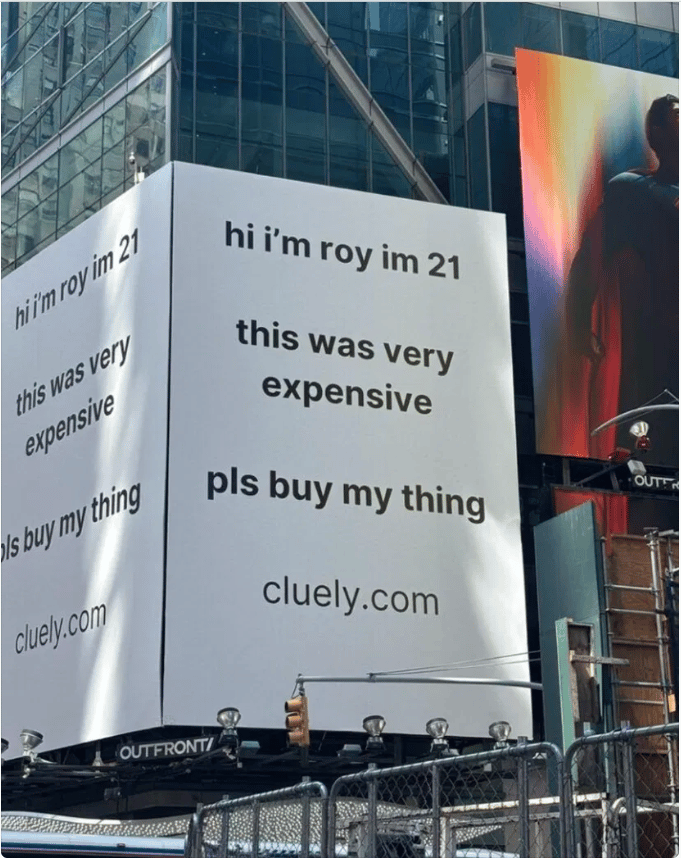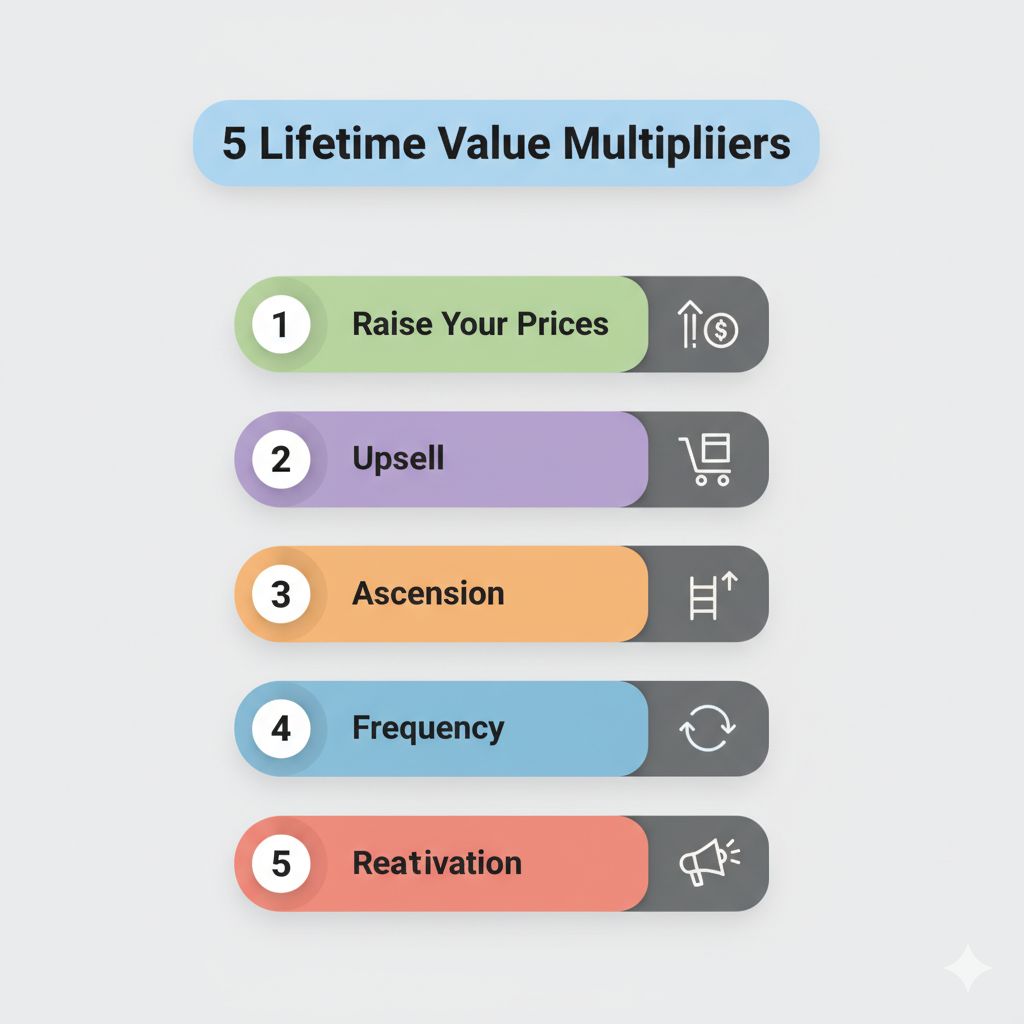Hi friends,
If you’re a marketer or a copywriter, you know the stress of writing a billboard ad; heck, even a social media ad.
And while having this in my mind, I came across a tweet.
The tweet was about an ad that I’d state as “dead simple.”
And tbh I never thought it would end up in Times Square.
Well, I’ll let you decide the rest.
Copywriting Example
Cluely's Billboard

August 2025. Times Square.
Roy Lee is 21 years old. His startup just raised $15 million from Andreessen Horowitz.
He could've hired the best creative agency. Shot a commercial with who ever he wanted. Covered Times Square with latest AI imagery.
Instead, he did this:
A billboard that looks like he made it in Google Docs.
White background. Black text. Lowercase. No punctuation.
"hi i'm roy im 21" "this was very expensive" "pls buy my thing" "cluely.com"
What the fuck!?
Now, if you're thinking, "This is stupid," you're not alone. Half the marketing world said the same thing.
But here's what actually happened.
The billboard went viral (of course it had to). Not because it was polished. Because it was raw.
Roy didn't hide the cost. He admitted it. Right there on the most expensive advertising real estate on Earth.
Most companies would’ve spent millions trying to make their ads look perfect. Roy spent a lot and then told you exactly how much it cost.
The psychological flip is brilliant.
When brands hide their advertising spend, you know they're hiding it. You feel manipulated.
When Roy admits "this was very expensive," your brain thinks, "Wait, he's being honest about the cost? Then maybe he's honest about the product too."
But the genius move isn't just the honesty. It's the casualness.
"pls buy my thing"
Not "Download Cluely Today!" Not "Revolutionary AI Technology!" Not "Limited Time Offer!"
Just... "pls buy my thing."
It sounds like your friend asking you to check out their side project. Not a corporation demanding your attention.
And that lowercase, no-punctuation style? That's not laziness. That's strategy.
Gen Z spends 1.3 seconds on ads before scrolling. Traditional polished ads trigger their "this is corporate BS" detector instantly.
But casual, vulnerable, slightly messy? That feels real.
Roy introduced himself by name. Admitted his age (which could've been a weakness). Confessed the billboard cost. Asked casually for a sale.
No manipulation. No pressure. No fake urgency.
The result? Millions of social media impressions. Thousands of Google searches. Endless debate among marketers about whether it was genius or stupid.
Which, of course, proved it was genius.
Because even the critics debating whether it worked were proving it worked by talking about it.
Here's the uncomfortable truth: In 2025, the most persuasive thing you can do is stop trying to persuade.
Roy didn't sell. He just admitted what he spent and asked if you'd buy.
That honesty? That's the new manipulation.
Marketing Secret
Lifetime Value Multipliers

I’ll tell you what. Getting new customers is hard but making money with existing customers? that ‘s not.
If you said "new customers," you're thinking like every business that's bleeding money on Facebook ads.
Here's the math that changes everything.
Getting a new customer costs 6-7x more than keeping an existing one.
But here's the part that your brain didn’t think: If you increase what each customer spends by just 5%, your revenue jumps 25-95%.
You don't need more customers. You need your customers to spend more.
Allan Dib figured out there are exactly five ways to do this. And most businesses use zero of them.
1. Raise Your Prices
Right now, you're thinking, "But I'll lose customers!"
Wrong.
A 5% price increase creates a 22% profit increase. Even if you lose 2-3% of customers (you probably won't), you still make more money.
Most businesses are scared to raise prices. So they're effectively lowering them every year because of inflation.
You're not charging what you're worth. You're charging what you're scared to ask for.
2. Upsell (The McDonald's Play)
"Would you like fries with that?"
That one sentence made McDonald's hundreds of millions of dollars.
Here's why it works: Your customer already decided to buy. Adding something else feels like a low-risk bonus, not a new purchase decision.
Amazon does this perfectly. "Frequently bought together." One click, and you've spent $40 more without thinking.
The trick? Make the upsell feel like common sense, not a sales pitch.
3. Ascension (Move Them Up)
This is different from upselling.
Upselling is "Want fries with that?" Ascension is "Ready for the premium burger?"
You're not adding to their purchase. You're replacing it with something better.
SaaS companies know this. Free tier → Starter → Pro → Enterprise.
Every time someone hits a limit on their plan, they're ready to ascend. You just have to show them the next step.
4. Frequency (The Secret Weapon)
If your customer buys from you four times a year, and you get them to buy monthly instead, you just tripled their lifetime value.
Same customer. Same product. No price increase.
Just more often.
Amazon Prime figured this out. Free shipping removes friction. Prime members buy 2x more frequently than non-members.
Not because the products are better. Because buying is easier.
5. Reactivation (The Forgotten Money)
You have customers who bought once and disappeared.
They're not mad at you. They just forgot you exist.
Bringing them back costs 6-7x less than finding new customers.
A simple "We miss you" email with a 15% discount reactivates 10-15% of dormant customers.
That's pure profit you're currently leaving on the table.
Here's what happens when you combine all five:
Let's say your average customer is worth $1,100 a year.
Raise prices 5%: $1,155 Add upsells: $1,328 Move them up tiers: $1,594 Get them buying more often: $2,391 Reactivate the ones who left: $2,630
You just went from $1,100 to $2,630 per customer.
Same customer. No new marketing. Just a smarter strategy.
Most businesses are burning cash trying to find new customers when they're sitting on a gold mine of existing ones.
You don't have a customer problem. You have a lifetime value problem.
Your homework this week: Pick one strategy. Just one. Raise your price 5%. Add one upsell. Send one reactivation email.
Watch what happens when you stop chasing new customers and start maximizing the ones you already have.
Talk soon,
Whenever you're ready, here are 3 ways I can help you:
A website thats more than a directory
Most industrial B2B sites are outdated. If not, “never exists.” I write homepage copy that makes people stop scrolling and build it on Webflow so it loads fast, ranks high, and most importantly, brings customers.Automate the boring stuff.
You’re not paying people to do what AI can do faster and cleaner. From following up with a lead without a salesperson to bringing inquiry on autopilot. I help you plug automation into your marketing website so you get hours (and profit) back.A “ free strategy” consultation
If you want to stand out from your competitor. Get noticed by your customers. Be known for what you do. Reply to this email with the subject “consultation” and your requirement and I’ll help you get out of where you’re stuck with actionable advice.